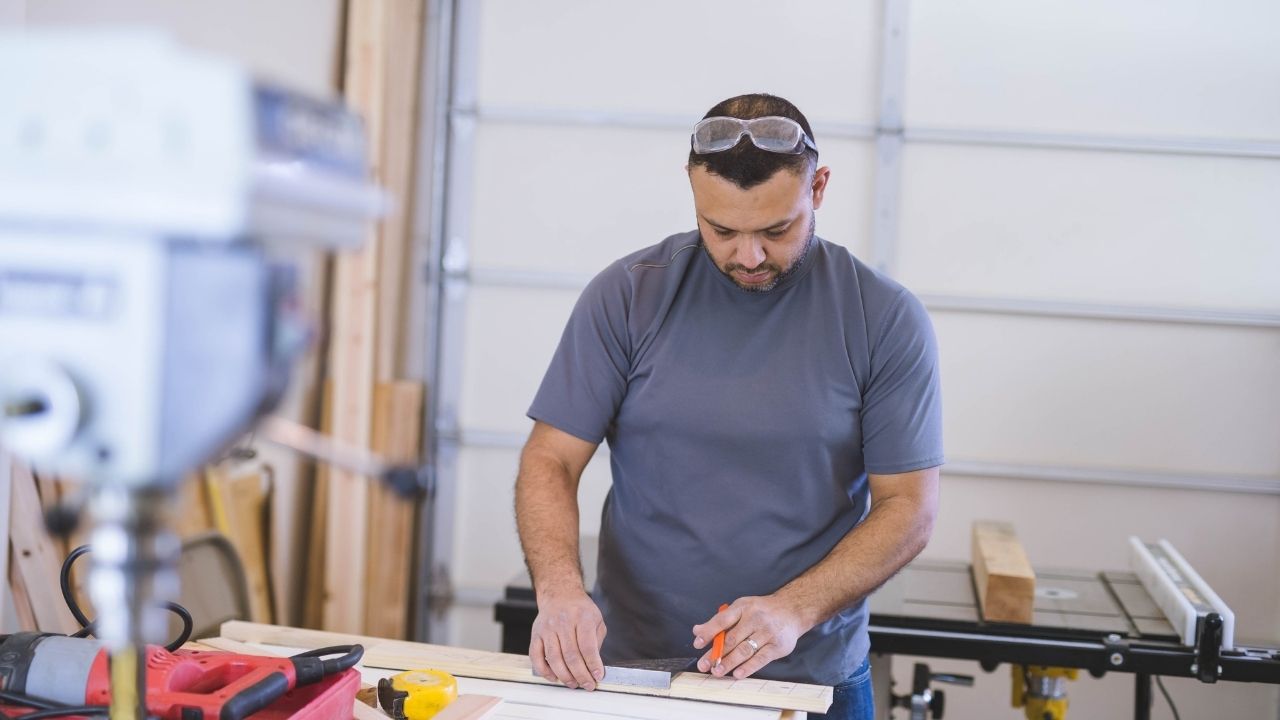Lifestyle
6 Tips to Help You Create the Ultimate Garage Workshop

A garage might be designed for parking cars and protecting lawn equipment from the elements, but these spaces are far more versatile. They can serve a variety of purposes – ranging from a teenage bonus room to a storage unit. But if you really want to make the most out of this space, you should consider transforming it into your ultimate garage workshop.
Whether you mess around with woodworking, do a little welding on the side, have a knack for home projects, or like tinkering with engines, a garage workshop provides the perfect environment for rolling up your sleeves and knocking out projects.
Here are a few helpful tips to assist you in creating the ultimate garage workshop of your dreams:
- Get a Solid Workbench
Every garage workshop needs a rock-solid bench to serve as the main work area. While you can make a workbench out of any number of materials, a hard and heavy top is absolutely key. You can either make your own or buy a premade option from the store.
“Premade workbenches run $100 to $500 and come in many lengths; they’re usually 24 inches deep,” home improvement expert Larry Erickson explains. “A 38-inch height is typical, but you might be more comfortable with a work surface as low as 36 or as high as 42 inches. Some benches include vises, drawers, and shelves.”
If you build one yourself, you should be able to get some quality materials for $100 or less. If you want some more complex features or finer materials, $300 to $500 is a more realistic price range.
- Establish an Organization System
It’s not the most engaging of topics, but a good workshop must be organized. Installing the right organization system from the start will ensure you have the space and freedom to work on projects without having to reorganize piles of junk every time you want to work.
There are hundreds of organization systems on the market, so we’ll let you choose which ones work best for you. Just know that vertical and overhead storage can save you a ton of space!
- Install Adequate Lighting
Garages tend to be pretty dark. You might be lucky enough to have a couple of windows, but they probably don’t let in the sort of natural light you need. Plus, opening garage doors during daylight hours can cast some mean shadows across your shop.
Make sure you install adequate task lighting to help you work in a safe and visible environment. While they may not be great for ambience, nothing beats overhead fluorescent lights in terms of cost and brightness.
- Keep the Space Comfortable
You want your workshop to be pleasant to work in. And while it probably won’t be as comfortable as the inside of your house, there’s no need to be miserable during the peak of summer or the freezing days of winter.
To ensure maximum comfort, insulate your garage doors. In the winter, try running a gas space heater to warm up the workshop. In the summer, a window AC unit or a couple of well-placed fans can create a cooling effect.
- Pay Attention to Air Quality
Whether you’re working with wood or engines, you need to do something to ensure your garage workshop has good ventilation and satisfactory air quality.
“A ceiling exhaust fan is a good start but if you are serious about keeping things clean then your ultimate workshop should also include a dust collection system, central vacuum and air ventilation system,” DIYer Timothy Dahl writes. “All three of these systems will keep the dust, dirt, and other heavy particles off your clothes and out of your lungs which makes for a safer work environment.”
- Customize to Your Liking
There are plenty of technical components to setting up a garage workshop – like setting up an organization system and purifying the air – but there’s also plenty of room to get creative.
Your workshop should be a place where you want to work. When you walk into your garage, it should be inviting and energizing. So make sure you customize it to your liking. Put up posters, display your projects, or install a TV so you can watch the big game. Do whatever you can to make this space yours!
Give Your Garage an Upgrade
Every workshop is going to look different – and that’s okay. At the end of the day, a workshop is an intensely personal environment. Take the tips you like, discard the ones you don’t, and architect a space that works for your needs. Before you know it, the garage will become your favorite room in the home.
Lifestyle
The Future of Education Through Patricia Vlad’s Eyes

The traditional systems that once defined learning, rigid curricula, standardized testing, and a narrow focus on academic performance, are increasingly being questioned. And why is that?
Starting in the 1880s, thinkers like John Dewey advocated for a shift in teaching methods, leading to the rise of progressive education. Unlike traditional models that emphasize rote learning and job preparation, progressive education puts students at the center of the learning experience. Changemakers like Patricia Vlad also believe that hands-on, experiential learning is the key to deeper understanding. This approach prioritizes critical thinking, curiosity, and personal passions, encouraging students to become lifelong learners who actively engage with new ideas and problem-solving. Schools and parents that embrace this model focus not just on what students need to know but on how they can continue to grow and adapt throughout their lives.
As the world changes, so do the skills, knowledge, and adaptability students need to succeed. The future of education is about personalization, inclusivity, emotional intelligence, and meaningful learning experiences.
With years of global teaching experience, Patricia has seen firsthand how different education systems approach learning. She believes that the future of education must embrace neuroscience, technology, and self-awareness to create a system that is not just efficient but also empowering for students.
“Education should be about more than just passing tests. It should equip students with the skills to navigate life, understand their strengths, and feel empowered in their learning journey,” Patricia emphasizes.
The Future Belongs to the Emotionally Intelligent
Unlike technical skills that may become obsolete with automation, EI – our ability to understand and manage emotions, build relationships, and navigate challenges, remains uniquely human. It plays a crucial role in self-awareness, resilience, effective communication, helping individuals excel in both personal and professional life.
When it comes to EQ, think of it like this: Kids with strong emotional intelligence are better at handling stress, resolving conflicts, and overcoming challenges. Studies suggest that EQ is a stronger predictor of long-term success than IQ. And let’s be real, no matter how advanced AI gets, it will never replace the depth and impact of human connection.
How LevelUp Cultivates Emotional Intelligence Through Patricia’s Coaching
1. Learning Will Be Personalized and Strength-Based
Instead of forcing students to fit into a system, education will be tailored to each child’s learning style, strengths, and interests. Neuroscience-backed methods – such as learning based on attention spans, emotional regulation, and brain development research – will be used to create adaptive learning environments, allowing students to progress at their own pace.
Through tools like LevelUp, which incorporates the Big Five Personality Model, teachers and parents will have a better understanding of a child’s cognitive profile, enabling them to offer more personalized support.
2. Emotional Intelligence Will Be a Core Part of Learning
The future classroom won’t just cover maths, science, history, or even language – it will also focus on self-awareness, empathy, and social skills. As research shows language doesn’t just communicate thought; it actively shapes it. The intentional use of language can influence how the brain processes emotion, memory, and social connection – making it a powerful tool for developing emotional intelligence.
LevelUp integrates EI into its framework, ensuring students not only understand themselves better but also build confidence, manage stress, and develop strong interpersonal skills.
3. Education Will Be More Interdisciplinary
The future of learning will move away from isolated subjects and toward interdisciplinary education, where concepts from different fields are connected and applied to real-world problems.
For example, students might blend neuroscience with psychology to understand learning processes or combine technology and art to develop creative solutions.
4. Technology Will Support, Not Supplant Human Connection
In the classroom of the future, meaningful engagement between students and teachers will remain at the heart of learning. Peer collaboration, hands-on projects, and real-time feedback from teachers will continue to be irreplaceable elements of education.
Technology will play a supporting role enhancing, rather than dominating, the learning process.
Whether through gamified modules, virtual simulation, or adaptive platforms, tools like LevelUp will be used intentionally to deepen understanding and personalize feedback, always in service of human connection, not as a substitute for it.
5. Schools, Parents, and Students Will Work Together
Education won’t be confined to the classroom. Parents will play a bigger role in guiding their children’s learning, using tools like LevelUp to track progress, support emotional development, and encourage curiosity at home.
By strengthening the parent-child-teacher connection, education will become a team effort, ensuring every student receives the support they need to reach their full potential.
A Future Built on Empowerment
By combining neuroscience, technology, and emotional intelligence, Patricia is helping to reshape education into something that prepares students not just for exams, but for life itself.
A truly effective education system values each student’s creativity and passions—not just their ability to recall information. Instead of just delivering information and expecting rote memorization for test scores, teachers encourage active, hands-on learning through projects, experiments, and peer collaboration. This approach allows students to explore topics that genuinely interest them, making learning more engaging, meaningful, and personal.
The LevelUp platform, developed under Patricia’s leadership, is contributing to a growing shift toward education that is rooted in self-awareness and real-world readiness. Additionally, emotional intelligence is a core part of learning, not an afterthought.
One story that sticks with Patricia is that of a student named Ethan, who had always been labelled “distracted” in class. His teachers described him as bright but inconsistent, often zoning out or fidgeting during lessons. When his LevelUp profile revealed high reactivity and strong openness, a new picture emerged: Ethan wasn’t disengaged—he was overwhelmed by too much information at once and thrived when topics were explored through hands-on, creative activities.
With this insight, his teacher began breaking tasks into smaller steps and introducing art and building projects tied to the curriculum. For the first time, Ethan started raising his hand during class and even stayed back after school to show his work. “We’d been trying to ‘fix’ him when all we needed was to understand him,” his teacher later shared.
It was a small shift, but for Ethan, it changed everything.
-

 Tech5 years ago
Tech5 years agoEffuel Reviews (2021) – Effuel ECO OBD2 Saves Fuel, and Reduce Gas Cost? Effuel Customer Reviews
-

 Tech6 years ago
Tech6 years agoBosch Power Tools India Launches ‘Cordless Matlab Bosch’ Campaign to Demonstrate the Power of Cordless
-

 Lifestyle6 years ago
Lifestyle6 years agoCatholic Cases App brings Church’s Moral Teachings to Androids and iPhones
-

 Lifestyle5 years ago
Lifestyle5 years agoEast Side Hype x Billionaire Boys Club. Hottest New Streetwear Releases in Utah.
-

 Tech7 years ago
Tech7 years agoCloud Buyers & Investors to Profit in the Future
-

 Lifestyle5 years ago
Lifestyle5 years agoThe Midas of Cosmetic Dermatology: Dr. Simon Ourian
-

 Health7 years ago
Health7 years agoCBDistillery Review: Is it a scam?
-

 Entertainment6 years ago
Entertainment6 years agoAvengers Endgame now Available on 123Movies for Download & Streaming for Free
